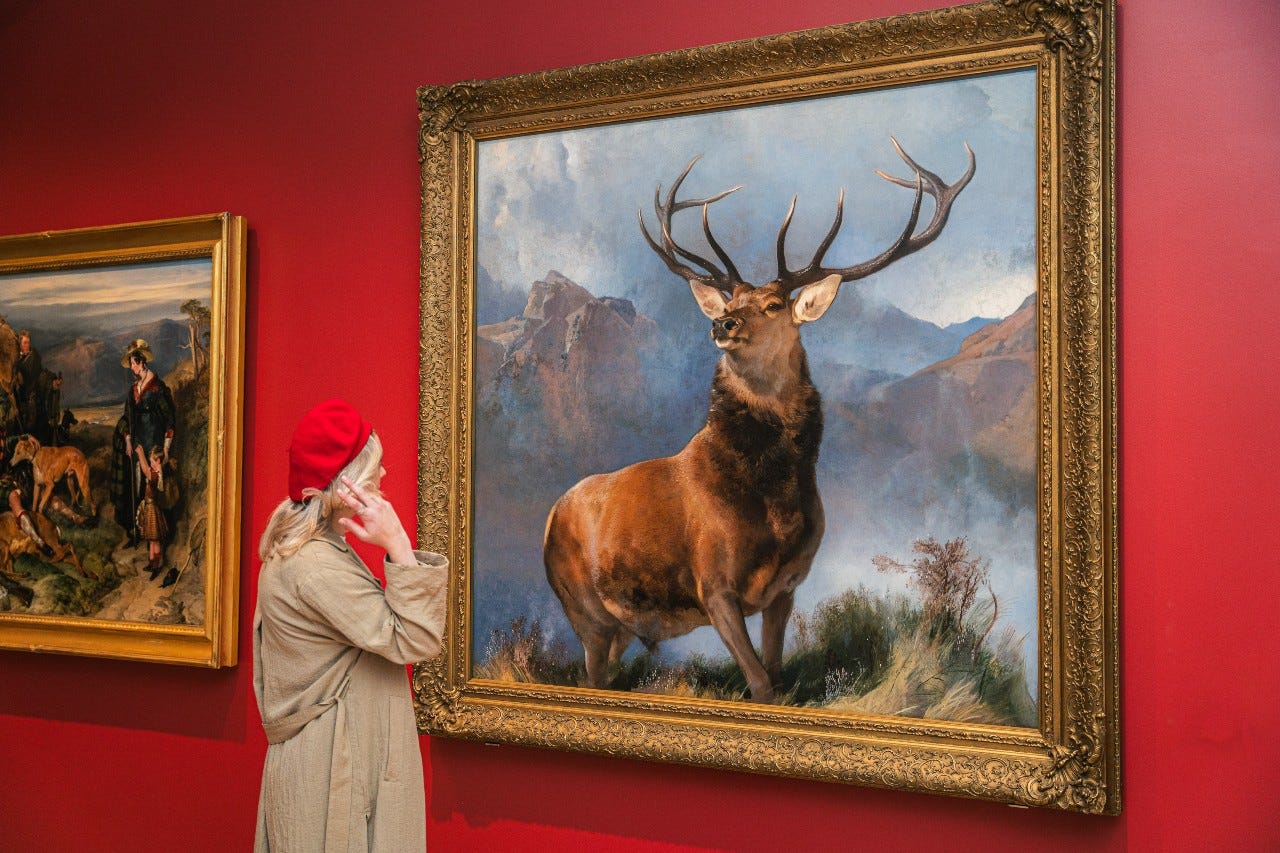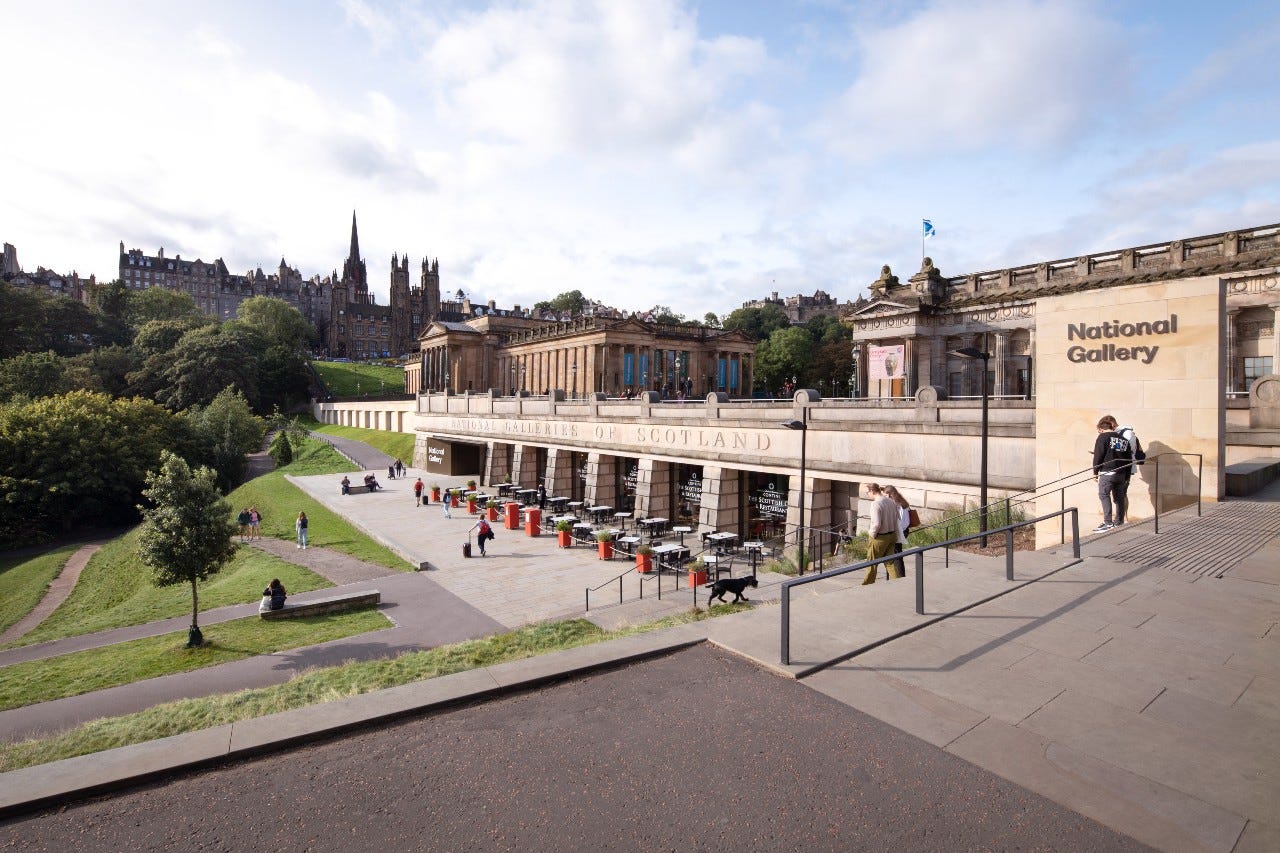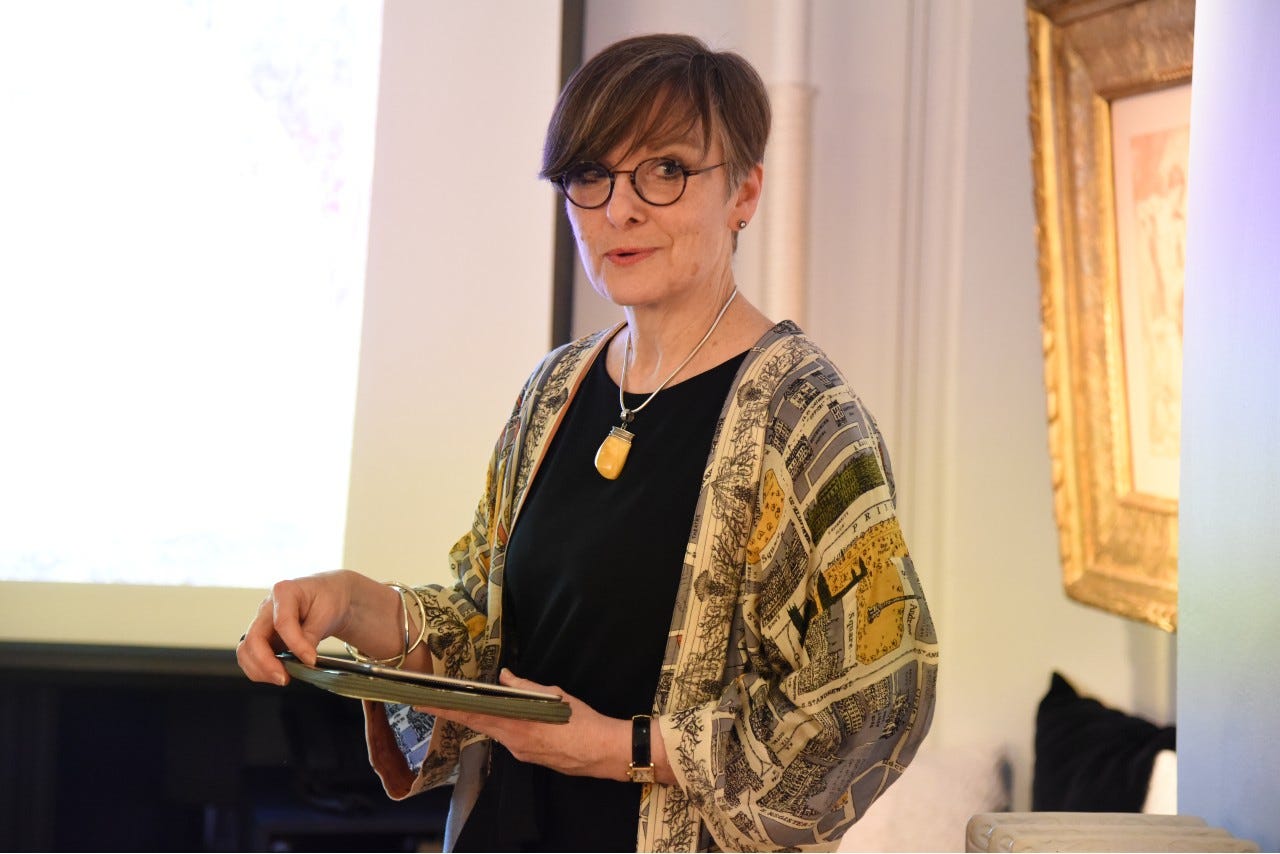Scottish art's £38m new home
INTERVIEW: Dr Tricia Allerston talks the National Galleries of Scotland's 'complex' new extention
“The construction of the new Scottish galleries was one of the most complex engineering projects undertaken in a heritage building in Scotland…but we got there!”
This is one of your twice-monthly special maxwell museums newsletter editions featuring my favourite recommendations, and one big interview. You get it in addition to your regular weekly news round-ups — keep an eye out for the next one on Friday.
Now let’s go to it!
The Hot List
maxwell museums’ curated round-up of what’s new to see, do, watch, read and more, From the UK — and around the world.
EXHIBITION
🔗 Mat Collishaw: Petrichor
Kew Gardens, London
Celebrated contemporary artist Mat Collishaw comes to the botanical gardens at Kew to showcase new commissions alongside existing works. This exhibition encompass sculptural installations using a variety of pioneering techniques including AI to explore the relationship between the natural world, art history, and how we see the world around us. Opens Saturday
EXHIBITION
🔗 Avery Singer: Free Fall
Hauser and Wirth, London
Hauser and Wirth’s London galleries have been transformed into New York City’s World Trade Centre on the morning of 9/11. There’s all the trappings of corporate America: carpet tiles, elevators and endless grey corridors. It’s an uncanny show exploring the artist’s personal experience of the terror attack, and society’s collective trauma. Until 22 December
EXHIBITION
🔗 Mark Rothko
Fondation Louis Vuitton, Paris
A major blockbuster retrospective of the American painter — his first in France this century — which features 115 paintings drawn from all over the world. Tate have loaned their entire Rothko room of nine paintings. Spanning his whole career and the whole Paris gallery, the Times review calls it a “revelation.” Opens today until 2 April 2024.
ART FAIR
🔗 Paris+ par Art Basel
Grand Palais Éphémère, Paris
Following Frieze week in London, the art world turns to the French spin-off of the Swiss mega art-fair which returns after last year’s inaugural edition. Over 150 galleries have descended on the French capital to highlight its rise to prominence in Europe’s contemporary-art scene. This year’s edition also features free-to-visit events and installations outside of the fair’s walls. From today until Sunday 22 Oct
ONLINE TALK
🔗 Demystifying Museum Careers: The Role of the Marketing Manager
Online
Do you want to work in marketing in museums or in the heritage sector but aren’t sure where to start? This webinar from V&A Academy is for you. Hear the V&A’s Senior Marketing Manager Emma Zeitlyn reveal how she markets their free offering and public exhibitions, covering everything from planning, strategy, creative development and copywriting. 24 October 13:00. Free
— Support this newsletter now by donating £5. Every penny is gratefully received
The Big Interview
Last month, Scotland’s national collection of Scottish art finally got a new home that befits it. It was a long time coming, not least because that new home arrived five years later than first planned — and at double the cost to boot.
But if the reviews from the art critics are anything to go by, the National Galleries of Scotland’s new Scottish galleries were worth the wait. “Ravishing” was the Guardian’s verdict, “beautifully lit and spacious” said the Times. And simply “a triumph” said the Scotsman.
The new suite of 12 rooms at the National (formally the Scottish National Gallery) have been created underneath the original 19th Century building on Edinburgh's Mound. Built at a cost of nearly £40 million, they showcase about 130 items of Scottish art over 150 years from 1800 to 1945. It was funded by major contributions from the Scottish Government, the National Lottery Heritage Fund and a successful public fundraising campaign.
The project has transformed the visitor experience, doubling the physical display space compared to the previous “cramped and dark” galleries for these masterpieces. There are new spectacular views over the city for visitors to enjoy before they take in works by artists such as Charles Rennie Mackintosh, the Glasgow Boys and one of the most celebrated paintings in the world, The Monarch of the Glen by Sir Edwin Landseer.
So for this week’s interview, I speak to the Dr Tricia Allerston, Deputy Director and Chief Curator at the National Galleries of Scotland, but crucially, also the person tasked with leading this multi-million-pound project as Co-Director. Here we chat about the complexity of the building work, the curatorial challenges, and the number of sleepless nights due to such a major museum milestone
***
Hello Tricia. Congratulations! The new Scottish galleries at the National have been open a few weeks now. How did it feel when you first saw visitors coming through the doors?
There was a real buzz at the National on the morning of the opening. We rolled out a large rubine red carpet and dressed the beautiful new stone terrace with art crates decorated in our bright brand colours. A crowd had gathered even before our piper began to play.
Colleagues who had been closely involved in the project, including our ‘big boss’ Sir John Leighton, came to witness the event. It was thrilling to see visitors surge through the new main entrance at 10am, but even more exciting to wander through the new galleries during the day and see (and hear) visitors obviously enjoying themselves.
This has been a huge project, at a cost of over £38m. Give me a sense of the scale of the work.
The National Galleries of Scotland started focusing on the project once the refurbishment of our Scottish National Portrait Gallery was completed in December 2011. A feasibility study was undertaken in 2012, allowing a capital project to be initiated. First, a design team was employed (Hoskins Architects & Metaphor exhibition designers) and we had to develop the project and make several major applications before we could engage a building contractor.
These applications were for: a Parliamentary bill to allow building work in Princes Street Gardens; Planning consent (no mean feat given we were extending an A-listed historic building at the heart of the Edinburgh World Heritage site and above the main railway line to Glasgow and the north of Scotland); and funding, including a substantial two-stage bid to the National Lottery Heritage Fund in 2014 and 2016.
Higher than projected initial tender costs, largely due to our plans to build above the railway lines, necessitated a change in design, in 2017, and this required a second, completely new application for Planning consent.
The construction of the new Scottish galleries was one of the most complex engineering projects undertaken in a heritage building in Scotland; working within the constraints of a UNESCO World Heritage site, above long-established railway tunnels and excavating beneath a category-A listed building. Several unforeseen issues with the site and the original 1970s construction were uncovered during this major construction project. Unfortunately, delays caused by these challenges with the site, combined with the impact of the pandemic, inflation and supply issues in the wider construction industry led the costs to increase further. But now we’re here, we’re open and this new experience right in the heart of Edinburgh’s city centre is free for everyone to enjoy.
Everyone at the National Galleries of Scotland has been involved in the project at some stage. Our conservation team alone surveyed 673 paintings, about 700 frames and 240 artworks on paper, to decide where their work was most needed. They eventually undertook 15 major painting restorations and treated about 200 other paintings; technical examinations of 100 drawings, treating 30 and remounting 100; and worked on about 250 frames, making 7 reproduction historic frames from scratch.
The 12 new gallery spaces showcase the very best Scottish art like never before. We’re incredibly proud of what we’ve achieved.
Was Scottish art underserved at the gallery before these new spaces — and what will they do to the visibility of Scotland’s artistic heritage?
The Scottish collection makes up about half of the entire collection of the National Galleries of Scotland. In the late 1970s an extension had been built underground at the National to show highlights from this collection, but by 2012 this additional gallery was no longer fit for purpose. It was hard to find within the National gallery complex and no longer conformed to accessibility guidelines. It was cramped and dark and audience research revealed that neither visitors nor visitor-facing staff wanted to spend much time there. And it could not accommodate large artworks or the steadily growing collection.
An ‘intelligent camera’ installed for 18 months before closure showed that less than 19% of visitors entered this part of the building, and an additional programme of in-gallery observation by volunteers revealed that of that 19%, most visitors spent very little time in the gallery.
Having a new set of Scottish galleries accessed directly from the Main Entrance radically transforms how we present Scottish art at the National.
Were you surprised by how positive the response was by the public fundraising campaign?
We knew how rich, interesting and important the national collection of Scottish art was and that it was much loved by the members of the public that knew of it. We were sure that once this collection had been properly highlighted and introduced, and its importance made more widely known, then its potential for attracting support would be clear.
Raising funds is never easy – there are so many excellent causes vying for attention – but we were convinced of the merits of this collection and completely committed to championing it. We are absolutely delighted by the positive public response.

Is Scotland’s art appreciated as much as it should be in the wider UK? Do you hope the new galleries change perceptions?
Knowledge about Scottish art is limited even in Scotland, as the history of art (let alone Scottish art) is not taught widely in schools. A key part of our role at the National Galleries of Scotland is to champion and facilitate access to Scottish art. The new galleries at the National, our busiest site, and accompanying digital resources make this role much easier. We aim to build on them, using the project as a springboard to enable more people, both within the UK and much further afield, to appreciate Scottish art.
Curatorially, what are some of the biggest challenges of a project like this?
Seeing the art that will be displayed helps visitors, peers and champions to get a sense of the potential of the project. We were able to hang two upper galleries at the National with highlights from the Scottish collection and to tour some key works of art, but a lot of the collection was necessarily in store or in the conservation studios during the extended period of work on the project. This made it difficult to bring the content and new displays within the project to life.
The pandemic didn’t help as access to the stores and conservation studios was limited for internal researchers, let alone externals. Some of this was ‘deep’ off-site storage and therefore even more tricky to access. Similarly, access to the building site was limited for curators and other colleagues, especially during the pandemic, but also for an extended period afterwards, as the contractors continued to practise social-distancing and needed to progress the project without interruptions.
Like many relatively small institutions we are very busy and have a number of projects on the go at any single time, including a busy public programme. Keeping everyone focused on the end result during a long-term project is always a challenge.
Any sleepless nights?
A few, especially in the months leading up to opening when everyone became focused on the opening and needing information and input from a very small project team, but we got there!
What are your personal favourites from some of the 130+ artworks on display?
William Johnstone’s 1929 painting A Point in Time, because it is highly important in modern Scottish art — and so unusual — and I love the idea of showing it at the National, where it has never been before, to my knowledge. Frances Macdonald MacNair’s 1900s work Sleep too. It’s really mesmerising and highlights the potential of this incredibly creative artist. Rarely shown as it is a fragile watercolour on vellum. William Bell Scott’s 1867 work The King's Quair has not seen in public since the late 1960s. A significant Pre-Raphaelite artwork that has now been made exhibitable thanks to a major conservation project. And Inverlochy Castle by Horatio McCulloch, which is a bit of a guilty pleasure. It’s beautifully painted and reminds me of the majesty of the Scottish Highlands (it’s close to Ben Nevis), but I doubt that it depicts a real Highland village of the 1850s.
What has been the reaction from visitors — and has any of the reaction surprised you?
It is still a bit too early to say, but reactions of most visitors (and critics) have been very positive. Visitors do appreciate the links between the paintings and the city views, and the colours of the highlight walls. What has been really interesting is the amount of positive commentary about the additional school pupils’ labels. These were part of a learning programme during the development period. The honest and frank commentary of young people seems to have caught visitors’ imaginations.
WACTH: Inside new-look Scottish Galleries after £38m renovation👇
Finally, who were some of the first people to see the completed galleries?
We held a special series of events for colleagues before we opened to the public. These were really lovely occasions. The highly positive and warm reactions gave us confidence to face the media and ultimately the public. They also gave us a chance to see how the new spaces worked with ‘real’ people in them and helped to create a super atmosphere internally in readiness for opening to the public.
The Scottish galleries at the National in Edinburgh are open now. Admission free.
— Enjoyed this interview? Donate £5 to this newsletter to support future editions with interviews with leading figures.






I visited in February. It is the most fantastic space full of extraordinary things. I particularly loved seeing the Phoebe Anna Traquair tapestries, the Scottish Colourists and a William Crozier oil painting of the city from Salisbury Crags.
Congratulations!
Lovely to hear more about the new extension and revised presentation of art in Scotland's National Galleries. I'll certainly take a look in person when next I'm in Edinburgh. Thanks for the inside news.
I'd like to ask about your interview process, was this an online interview... by email... or in person? Just intrigued as I've been wrestling with the in-person interview and how to capture the words so they're a good read. I'd also like to know who is behind the name Maxwell Museums. Is there a team of you? Thanks again.